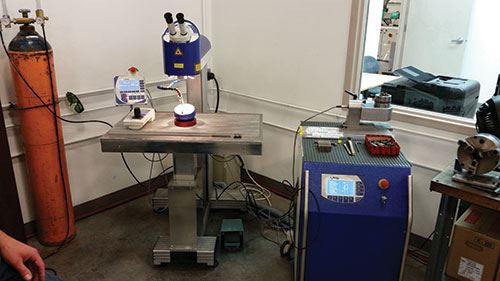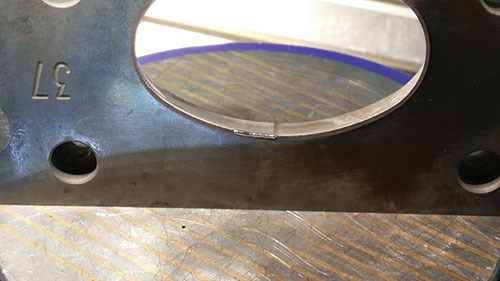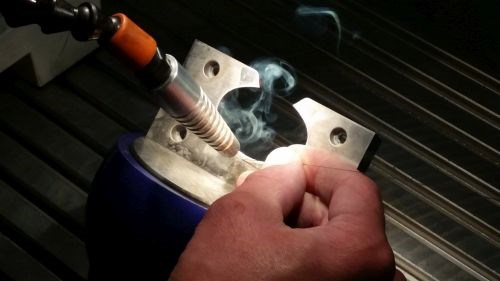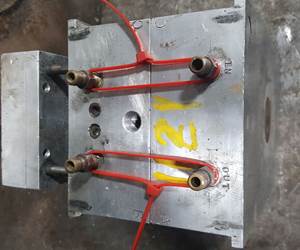Laser Welding Offers Low-Hanging Fruit
For this toolmaker and molder, laser welding capability offered an easy way to save time and reduce rework on repair jobs and engineering changes alike.
Summit Tooling didn't just send a delegation to this year’s International Manufacturing Technology Show (IMTS). It practically invaded. "We brought the entire tool room,” says Dan Martin, president of the McHenry, Illinois-based toolmaker and injection molder. “I like bringing employees along for things like that because it gets everybody excited about the new things that are out there.”
Building enthusiasm for what’s to come is particularly important at Summit Tooling because equipment and processes are constantly in flux, and change doesn’t always come easy. For example, witnessing and discussing the potential benefits of automation firsthand at IMTS helped ease anxiety over the adoption of the company’s first-ever robotics. Yet, not all the changes of the past half decade or so have been as dramatic as the still-ongoing push toward greater automation. Others were not only less extensive and less expensive, but also lucrative enough to have paid for themselves many times over.
Among the best examples of that, Martin says, is the integration of laser welding capability. Manufactured in Germany by Vision Gmbh and purchased through Alliance Laser Sales, the LWI IV Flexx motorized workstation is able to precisely lay beads measuring only 0.005-inch thick without deforming the surrounding workpiece material. This not only saves time during the initial weld, but also limits the need for further operations. As an added benefit, the system has proven easy and intuitive to use for operators of all experience levels, Martin reports. Since installation, it has been employed for an estimated 90 percent of all the company’s welding work.
Beyond Repair
Much of that work involves a traditional application for welding equipment: repairing damaged or worn mold surfaces, whether on tools running in customers presses or those at the 19-year-old company’s own dedicated molding division, Summit Plastics. Either scenario can involve a wide variety of mold types because the business is highly diversified, with both divisions taking on low-volume and production applications alike for industries ranging from packaging to electronics to automotive.
However, applications for the laser welder extend beyond just touchups. One of Summit’s key competitive strengths, Martin explains, is leveraging the strengths of both the 20,000-square-foot tool-making division and the 10,000-square-foot molding division to quickly prove out new tool designs.
He adds that “quickly” is the key word here, because most of the 24-employee company’s prototype molds aren't recognizable as such. Hot runner systems, sharp corners, slide actions, complicated gate configurations—all are common features among prototype tools that are often delivered within a few days of an order. Any one of these projects might require as many as 15 different design iterations. During the resulting back-and-forth, laser welding is particularly effective for performing quick, minor alterations without rework. Typical examples include eliminating a serial number or building up worn areas of a cavity to eliminate flash.
No Chasing the Gap
None of these applications are entirely new for Summit. After all, fast turnaround requires doing as much work as possible in-house (“About the only operation we don't perform is heat treating,” Martin notes). Thus, welding has long been a part of the company’s repertoire. However, he says the laser’s precision and lack of heat generally make the machine more effective than the two micro-TIG units that previously handled the bulk of this work.
The exception to that rule is larger welds that offer the luxury of prioritizing speed over all else. However, the more precision required for the weld, the greater the risk that heat generated by the micro-TIG process will deform the surrounding material, he says. Even with the smaller of the two older units, which has a power supply rated at 1 amp, operators might find themselves “chasing” the resulting gap by welding out into fresh workpiece material at a lower temperature. This takes time. Then, after the weld, removing excess material often requires downstream hand-grinding, possibly at the expense of more value-added activities. In some cases, finishing the job even requires tying up a milling machine.
The company’s 100-Watt LWI IV Flexx limits these risks because comparatively little heat radiates beyond the point of the weld, Martin says. Moreover, precise control of 0.5- to 20-ms pulses ranging to 20 Hz enables placing beads exactly where the job requires. As a result, operators rarely have to perform any more than a cursory grind, assuming any rework is called for in the first place. This is particularly advantageous for engineering changes like those described above, given the need for fast turnaround. “You can pull something out that’s literally just been welded, and it’ll be cool to the touch,” Martin says. “We could probably weld a bead on the edge of a worn razor blade, grind it off and leave a perfectly sharp edge like nothing had ever happened.”
Although gains can be difficult to quantify when few jobs are the same, one particular variety of work recurs often enough at Summit to draw a comparison between the two processes. Consumer product applications often involve using inserts to mold the hinged portions of flip-top cap closures. These hinge inserts tend to require relatively frequent repair because they’re located at a critical shutoff point. With the shop’s micro-TIG welders, such a job might take between 5 and 7 hours. In contrast, the laser welder can complete the work in only 2 or 3 hours, Martin says. In either case, the customer saves hundreds of dollars compared to the cost of a new insert.
A Natural Fit
Although integrating any new technology involves a learning curve, the one associated with laser welding was relatively easy to negotiate, Martin says. “The training on it is fairly simplistic,” he says. In fact, he says neophyte trainees often had an easier time learning the system than seasoned welders, who had become accustomed to moving the torch and rod around the part. In contrast, laser welding requires moving the part around the torch, a task made easier by programmable, rotating fixtures and other workholding accessories.
All in all, laser welding was a natural fit for Summit Tooling, Martin says. The system not only significantly improved turnaround time on repair work and engineering changes alike, but began doing so almost immediately upon installation. In fact, realizing a complete return on the investment took less than a year. “We’ve seen major reductions in welding time and rework,” he says. “We’re turning work around faster than ever before, and that’s not just because of robotics and other major changes. Adding this single machine has been huge.”
Related Content
Portable Low-Heat, Non-Arcing Resistance Welder for Mold Repair
Rocklin’s user-friendly MoldMender Micro Welder delivers simple and cost-effective localized repair in-house with precision and versatility, enhancing mold and die durability and reducing disassembly and downtime.
Read MoreThink Safety: Eliminate Hazards Throughout the Shop
The tooling community is taking advantage of new products for safer mold shops and molding facilities.
Read MoreThe Ins and Outs of Hot Runner Temperature Control
A training checklist that explains the why and how of proper hot runner temperature control and system management.
Read MoreWhat You Should Know About Injection Mold Safety Straps
Every mold should have one in order to be safe and OSHA compliant.
Read MoreRead Next
Reasons to Use Fiber Lasers for Mold Cleaning
Fiber lasers offer a simplicity, speed, control and portability, minimizing mold cleaning risks.
Read MoreHow to Use Strategic Planning Tools, Data to Manage the Human Side of Business
Q&A with Marion Wells, MMT EAB member and founder of Human Asset Management.
Read MoreHow to Use Continuing Education to Remain Competitive in Moldmaking
Continued training helps moldmakers make tooling decisions and properly use the latest cutting tool to efficiently machine high-quality molds.
Read More

























